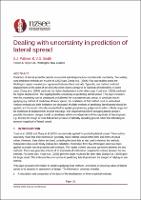Dealing with uncertainty in prediction of lateral spread

Download
Date
2022-04-27Authors
Smith, Vincent
Palmer, Stuart
Elwood, Kenneth
Metadata
Show full item recordAbstract
Prediction of lateral spread for seismic assessment and design includes considerable uncertainty. Two widely used prediction methods are Youd et al. (2002) and Zhang et al. (2004). Five case studies across the Wellington region revealed poor agreement between these methods. Typically, one method predicted displacements of the order of ten times the other; metres compared to hundreds of millimetres. In some cases, Zhang et al. (2004) predicted the higher displacement and in other cases Youd et al. (2002) predicted the higher displacement. This highlighted the uncertainty in predicting lateral spread. This paper considers how this uncertainty can be understood and allowed for in assessment and design. It concludes that in applying any method of prediction of lateral spread, the limitations of that method must be understood. Various methods and their limitations are discussed. Multiple methods of predicting lateral spread should be applied, and the results critically assessed before applying engineering judgement to select a likely range and the likelihood of displacements beyond this range. It is proposed that where damaging lateral spread is possible, foundation designs should be developed which are independent of the magnitude of lateral spread, e.g. develop the design to resist full passive pressure of laterally spreading ground rather than tolerating an assessed magnitude of lateral spread.
